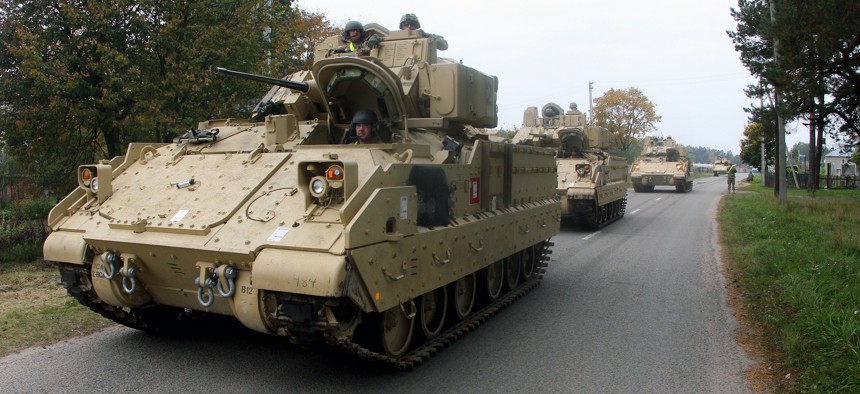
Members of the US Army 1st Brigade, 1st Cavalry Division, drive Bradley Fighting Vehicles from the railway station near the Rukla military base in Lithuania, on October 4, 2014. PETRAS MALUKAS/AFP via Getty Images
Bradleys, Self-Propelled Howitzers Head to Ukraine as More Difficult Fight in the South Awaits
The biggest U.S. aid package yet reflects new realities on the ground.
The Defense Department on Friday announced its largest aid package to Ukraine to date, a reflection in scale and content of Ukrainian advances in proficiency and territory.
Valued at more than $3 billion, the package includes 50 Bradley fighting vehicles, 100 M113 armored personnel carriers, 18 self-propelled howitzers, missiles, munitions and more.
U.S. President Joe Biden previewed the announcement Thursday during remarks at a White House cabinet meeting.
“We’re going to provide the Bradley infantry fighting vehicles—the United States—to the Ukrainians, and the Germans are going to provide the Marder infantry fighting vehicles that they have to the Ukrainians,” Biden said.
The announcement comes the same week as a promise from France to provide AMX-10 RC armored fighting vehicles.
The Bradleys in particular represent a step up in the sorts of equipment that the United States has said it will provide. They come with 500 TOW anti-tank missiles and 250,000 rounds of 25mm ammunition, but they aren’t quite as capable as the U.S. M1 Abrams tank, which the U.S. is still reluctant to send to Ukraine.
Laura Cooper, deputy assistant defense secretary for Russian, Ukrainian, and Eurasian affairs, told reporters at the Pentagon on Friday that the donation of the Bradleys reflects the progress that Ukraine has made in maintaining and equipping its forces. It also reflects the current state of the conflict, which has seen Ukrainian forces press toward deeply reinforced Russian positions in the south and eastern portions of the country.
“This is the right time for Ukraine to take advantage of its capabilities to change the dynamic on the battlefield,” Cooper said. “And from a maintenance and sustainment standpoint—and this is really important—the Ukrainians have demonstrated a lot of growing proficiency in maintenance and sustainment both within Ukraine and relying on new systems that we have set up with our allies and partners to provide what we call tele-maintenance in many instances. So at this point, the Ukrainians really are set up for success once we are able to train them on the system.”
Cooper also highlighted the importance of upcoming U.S.-led joint maneuver and combined arms training, both in helping Ukraine operate new types of weapons and in attacking entrenched Russian positions.
“We believe that through the combined arms training, they will better be able to integrate all of their different capabilities. That includes artillery, you know, all range, all types of fires, as well as maneuver to be able to make greater progress on the battlefield and really push back on these Russian positions. So that's what we're looking forward to seeing in the coming months,” she said. That training is set to start later this month in Germany.
The biggest-ever aid package reflects changing Western attitudes toward arming Ukraine and the new realities of the battlefield. Russia, having lost more than half of the territory it seized at the start of the war, is now hunkered down along the southeastern coast of the country and the Donbas. This week, a senior White House official said that “the Russians have dug in, really dug in, down towards the south. They have taken much more defensive, much more focused [positions] more on defensive lines and defense…in depth down in the south than they have in the northeast.”
The Biden administration’s hope is that more intense joint maneuver and combined arms operations will erode those reinforced positions at minimal loss to the Ukrainians.
Some additional munitions in the package announced Friday include RIM-7 “Seasparrow” air-defense missiles, and 4,000 Zuni aircraft rockets that can be mounted on fixed- or rotary-wing aircraft. Cooper emphasized that the Zunis are specifically for short-range air-to-ground operations.
The decisions by the United States, Germany, and France to send Ukraine infantry fighting vehicles marks the latest shift in how NATO arms Ukraine. What started as anti-tank weapons and older Soviet-made arms has now switched to more sophisticated, western weapons.
“Whilst Ukraine’s ultimate goal in materiel aid likely remains fully fledged main battle tanks, these new deliveries will be cause for optimism and a valued addition to the Ukrainian military,” James Marques, an associate aerospace, defense and security analyst with GlobalData, said in a statement. “They will provide enhanced firepower against Russian armor, and crucially protect infantry from ever-present artillery, which is essential to enabling future maneuvers to break the current stalemate.”
The U.S. Army is in the early stages of replacing its Bradleys with newer fighting vehicles. But it’s not expected to choose a winner of an ongoing competition until at least 2027.
On the eventual need to replace the Bradleys now headed to Ukraine, Cooper said, “Congress has granted us replenishment funds so that we can actually go out and purchase capabilities to backfill what we have provided in cases where it's an ongoing need.”
And the decision to give Western fighting vehicles could pave the way for even more sophisticated weapons down the road.
“As we have seen over the course of the war, milestones in aid, such as these new vehicles, often pave the way for further deliveries of more powerful capabilities at scale,” Marques said. “As Russia continues to falter, Western officials may sense an opportunity for Ukraine to seize further initiative in the coming months—a palpable goal that may have ended their hesitation to send such weapons.”
In recent weeks, the U.S. has also pledged satellite-guided JDAM smart bombs to Ukraine.



